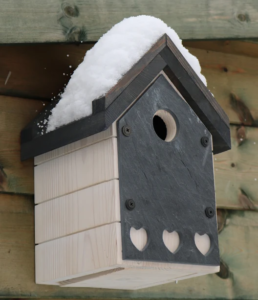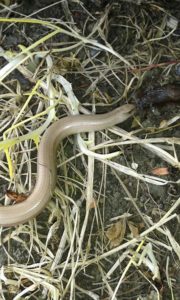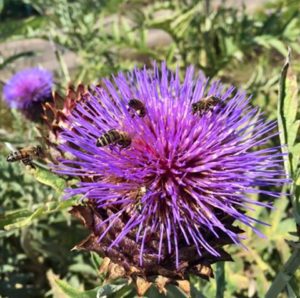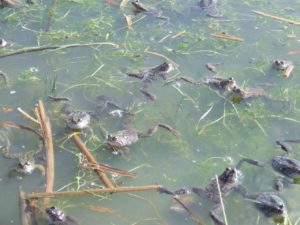Gardening for wildlife
Why consider wildlife on your allotment? There are many advantages of encouraging wildlife into your allotment plot. These include:
- Better pollination of crops by insects you’ve encouraged on to the plot.
- Pests, including slugs and snails, can be reduced if predators such as frogs and hedgehogs are encouraged on to your plot
- It can help to build in a balanced ecosystem with plants, birds, insects and mammals all co-existing and benefitting each other.
- A wildlife-friendly plot is a joy to behold with butterflies, bees and birds flitting around. Who doesn’t like seeing a robin nearby when you are digging?
- Companion planting of flowers next to crops can help deter pests from damaging your precious crops.
- Making your allotment plot wildlife friendly doesn’t necessarily mean that you have to leave it to grow into a wild jungle. There are lots of simple things you can do to help the animals, from making sure that they have access to different habitats, to nurturing well-stocked feeding grounds for them.

The main factors in helping wildlife thrive are:
- Where they live – habitats and homes
- What they eat – food and foraging
- How we grow our crops and treat our land – sustainability
There may be some tension between the allotment gardener and some wildlife: the caterpillars of the large white and small white butterflies can be a nuisance for cabbages; hungry pigeons can peck away at brassica crops; blackbirds like eating ripe plums and strawberries, and badgers can devastate a sweet corn patch. However, by taking precautions, such as netting crops, the worst of the damage can be avoided. On the whole, wildlife is hugely advantageous to a plotholder.
Here are some key factors for a great wildlife-friendly allotment plot.
Habitats and homes
Even the smallest of allotment plots can offer up a huge variety of different habitats for wildlife. It’s good to create as many habitats as possible without cramming too much in. Think about the space you have available and focus on making these microhabitats as good as they can be. Allotments can be busy worlds of wildlife heaving with nature.
- If your allotment is next to a hedge, this can offer roosting and nesting sites for birds and mammals, as well as valuable shelter and cover from the elements and possible predators.
Birchall Plot bird box
- Put up a bird box either on a nearby tree or attach it to your hut. Birds such as tits love to nest in birdboxes. Natural roosting and nesting sites can be increasingly hard to find and nestboxes give a safe alternative.
- Water features can be a habitat for a huge variety of animal life, from amphibians and invertebrates to bathing birds. Although ponds are generally not allowed on the allotment plots, even a small amount of water could be a useful source for birds and amphibians. Try embedding a bucket of an upturned dustbin lid into the ground to gather rainwater
- Woodpiles, discarded weed heaps and the decomposing off-cuts from your plot, can be incredible places for animals to live, feed and hibernate. If your want to be more sophisticated why not construct a hedgehog home on the plot.
- Dead wood, trimmings and old foliage can be a valuable hiding place for beetles and other insects and minibeasts, as well as fungi and moss
- Bat boxes can be put up on trees or on your hut to encourage bats to roost. The allotment is a great place for flying insects so there is plenty of food for the bats to enjoy.
- Butterflies need breeding sites too, and growing the right plants can give them a place to breed and lay their eggs. A variety of different host plants will attract a more varied range of insects: honesty and hedge garlic can be good for orange tip butterflies; buckthorn bushes are favourites for breeding brimstones; and nettles are good for red admiral and small tortoiseshell butterflies.
- A compost heap is a excellent place to find slowworms. It can also encourage hedgehogs and other small mammals
Slowworm on Birchall compost heap
Food and forage
Another essential feature of a wildlife friendly garden is a variety of places for the different animal residents to forage and feed. Of course, we can provide food for some of them, such as birds and hedgehogs, but there are lots of ways which we can help nature provide too.
- Flowering plants and shrubs, give nectar rich food to butterflies, bees, wasps, and hoverflies which, in turn, pollinate our plants. By planting a range of plants which flower and seed at varied times throughout the year you will provide food for the animals and insects that are active and feeding over different periods.

- Keep a wild patch on your plot, maybe near the edge or on the boundary of the hedge. This can encourage butterflies and moths to lay their caterpillars, which in turn will be food for birds.
- If you are looking to cut back overgrown areas, or untidy borders, wait until late winter or early spring, to give any minibeasts sheltering from the cold winter month the chance to move on.
- Berry bushes and fruit trees will give another source of valuable and irresistible seasonal food. Keeping some aples on the trees overwinter will give a winter feed for the birds. Blackthorn in the hedges provide sloes which wintering flock of birds like to eat.
- By encouraging minibeasts and insects, you’re also providing wealthy feeding ground for insect-eating birds, grub-hungry chicks and minibeast-eating mammals like hedgehogs and bats!
- A source or clean safe water is as important as food, whether it’s a larger pond (such as on Golden Hill) or a small dish set into the ground.
- Put up a bird feeder and regularly refill with wild seed mix or peanuts, especially during the winter months
- If you know there are hedgehogs around your plot, you may wish to put our food for them: they loves earthworms, slugs and snails
- By encouraging butterflies and moths, you will also make sure their caterpillars have the right plants to feed on. Caterpillars, in turn, will help the birds by providing food for hungry chicks during the breeding season.
Organic gardening and sustainability
Being sustainable and thinking of the environment is another important part of wildlife friendly gardening. So many of our actions have an impact on wildlife which goes beyond our gardens, and it’s important for us to think about this when choosing materials and creating our spaces.
- Make a compost heap on your plot and put all your kitchen waste, discarded plant material and other green waste on the compost heap. This is an excellent way to save money rather than buying compost, and, by avoiding peat you will help preserve vital habitats.
-

Compost on Golden Hill Find alternative forms of compost, rather than use peat. If you can’t make enough of your own compost, try to use compost from a sustainable source such as coir or compost made from bark or other renewable organic matter.
- Save rainwater in water-butts and barrels. This saves on the Allotment Association’s water bill. Rainwater is also better for topping up ponds and water features used by birds and amphibians.
- Recycle wherever possible. Use reclaimed, old materials when building compost bins, raised borders and other structures. Old pallets and scaffold planks can make great materials for building.
- If you must buy new timber for erecting structures such as a shed or raised beds on your allotment, ensure it is FSC accredited timber
- When planting native plants, ensure they are of genuine native stock and not of continental origin. Also, ensure ‘wild flowers’ have been cultivated from legally collected seed and not dug-up from the wild.
- Avoid using pesticides and use non-toxic, non-chemical alternatives. Horse and cow manure is a great source of the essential elements (P,N and K) and can be easily obtained from many sources locally, either in bulk by the lorry load or in bags. Other types of organic fertilisers include chicken pellets.
See the Allotment Supplies section on this website for possible sources of compost, manure and sustainable timber.
For more information of wildlife in our allotments, visit the Wildlife and Sustainability section of this website.



